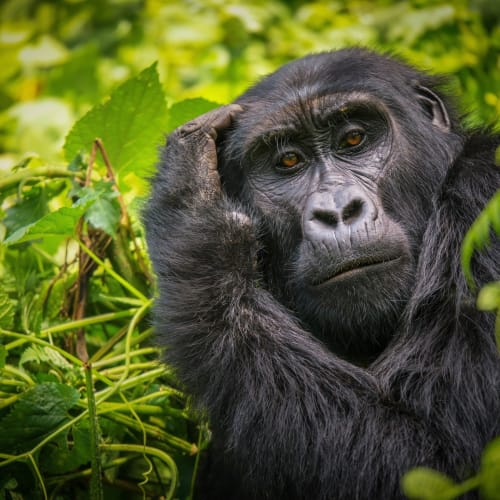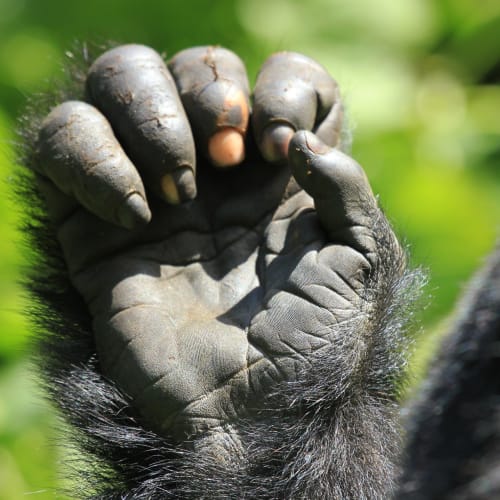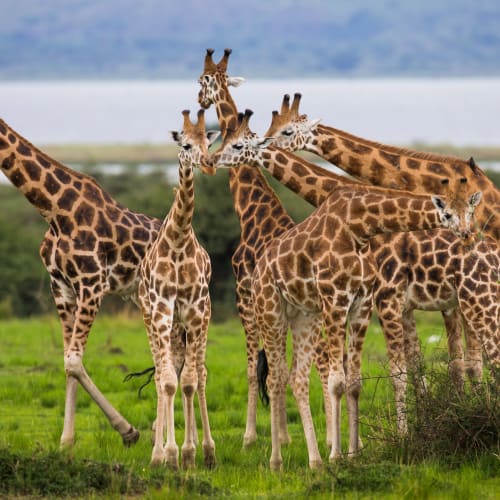
Wildlife in Uganda
Discover the fascinating wildlife of Uganda
Discover the fascinating wildlife of Uganda
Uganda is a dream destination for nature lovers and safari enthusiasts, impressing with its exceptional biodiversity and stunning landscapes. Some of Africa's most spectacular wildlife experiences can be found in world-renowned national parks like Bwindi Impenetrable Forest, Queen Elizabeth National Park, and Murchison Falls. From the rare and majestic mountain gorillas that live in the dense rainforests to the famous 'Big Five,' Uganda offers an unforgettable journey into the wild. In this article, we take you on a discovery tour of the most fascinating animals you can see on your journey through Uganda .
Mountain gorillas
The rare giants of the misty forest
The mountain gorillas in Uganda are among the rarest and most impressive animals in the world. Their main distribution area extends over two important national parks: the Bwindi Impenetrable National Park and Mgahinga Gorilla National Park. About half of the world's mountain gorilla population lives in the dense montane rainforest of Bwindi National Park. These majestic primates have adapted to the special conditions of the fog forest at altitudes between 2,200 and 4,000 meters. With their thick fur, they withstand the cool climate and prefer areas with a great variety of plants that serve as food sources. Male mountain gorillas reach an impressive size of up to 1.75 meters and weigh 200 kilograms, while females are slightly smaller. Their dark gray to black coloration is characteristic, with males developing the distinctive silver back over the years that identifies them as 'silverbacks.'
Observation opportunities
Uganda offers two outstanding locations for gorilla trekking: Bwindi Impenetrable National Park and Mgahinga Gorilla National Park. Bwindi National Park is the most significant place for gorilla watching, as several habituated gorilla groups live there that are accustomed to human contact. The best time for gorilla trekking is during the dry periods from June to August and from December to February. In Mgahinga Gorilla National Park, which is part of the Virunga Conservation Area, visitors also have the opportunity to visit a gorilla family. Since permits for gorilla trekking are limited, visitors should book them in advance to secure a spot. A maximum of eight visitors are allowed per gorilla group for one hour, making these exceptional encounters take place in an intimate and respectful setting.
Behavior and interaction
Mountain gorillas live in close social groups led by a dominant silverback male. The animals are known for their highly developed social behavior, which will fascinate travelers during their observations. The most common interactions include mutual grooming, which strengthens the bonds within the group, as well as playful behavior among the young. Particularly exciting is the observation of their communication among each other, which occurs through various sounds and body language. Mountain gorillas make daily treks to search for food. Their diet includes up to 34 kilograms of plant material per day, primarily leaves, shoots, and roots. Another fascinating behavior is the building of sleeping nests made from branches and leaves, which the gorillas construct anew each evening. Observing these unique animals in their natural habitat makes gorilla trekking in Uganda an unforgettable experience.
Chimpanzees
The clever relatives of humans
Chimpanzees are among the most fascinating primates in Uganda and can be found in various regions of the country. With a population of about 1,500 individuals, the Kibale National Park is home to the largest group of chimpanzees, followed by the Budongo Forest and smaller populations in Murchison Falls National Park and the Kyambura Gorge in Queen Elizabeth National Park. These impressive primates inhabit tropical rainforests, forested areas, and savannahs, living both on the ground and high in the tree canopies. With their dark brown to black fur and pronounced intelligence that allows them to use tools, they share about 98.8% of their genes with humans. Chimpanzees form social groups of up to 80 individuals, where complex hierarchies prevail, and they can live up to 50 years.
Observation opportunities
Uganda offers excellent opportunities to observe chimpanzees in the wild. Kibale Forest National Park is the best place for chimpanzee trekking, with a sighting probability of 90-95%. Visitors can also go on chimpanzee safaris in Budongo Forest in Murchison Falls National Park and Kalinzu Forest, with the dry seasons from December to February and June to September providing the best conditions. The morning trek, which begins at 8:00 AM, is particularly popular, but there is also a second tour option in the afternoon at 2:00 PM. Since permits for chimpanzee trekking are limited, early booking is recommended, especially during peak season. Trekking tours typically last 3-4 hours and take visitors deep into the tropical forests, where they can experience the chimpanzees in their natural habitat.
Behavior and interaction
Chimpanzees display a variety of fascinating behaviors that travelers can observe during trekking. They live in complex social groups where males demonstrate dominance through loud vocalizations or strikes against trees. A crucial social activity is grooming, the mutual care of fur that strengthens bonds within the group. Particularly impressive is their use of tools – they use sticks and leaves to obtain food and occasionally hunt smaller mammals. Chimpanzees build new sleeping nests high in the trees every evening and communicate with each other using a variety of sounds and calls. During a chimpanzee safari, visitors can experience these complex interactions and the remarkable cognitive behavior of the animals up close, making the encounter an unforgettable experience.
Lions
The kings of the savannah
Lions are native to Uganda in several national parks and reserves and are considered a symbol of African wilderness. Especially in the vast savannahs of the Queen Elizabeth National Park, Murchison Falls National Park, and Kidepo Valley National Park, these majestic big cats feel at home. With a shoulder height of up to 110 centimeters and a weight of up to 250 kilograms for males, they are the largest big cats in Africa. Their yellowish-brown to reddish fur, the imposing mane of males, and their penetrating roar, which can be heard up to 8 kilometers away, make them an impressive sight. As carnivores, lions primarily hunt medium-sized and large herbivores such as antelopes and buffalo, occasionally taking smaller prey. These highly social animals live in prides and have fascinating social behavior that distinguishes them from other big cats.
Observation opportunities
The best places to observe lions in Uganda are Queen Elizabeth National Park and Murchison Falls National Park. In the Ishasha sector of Queen Elizabeth National Park, visitors can observe the unique tree-climbing lions, a rare behavior found only in a few places in Africa. Particularly in the Kasenyi plains, there is a high chance of viewing lion prides while hunting or resting. The lion population is steadily growing in the more remote Kidepo Valley National Park, making it another ideal spot for lion sightings. The best time for a lion tracking safari is during the dry seasons from December to February and from June to September. Early morning and late afternoon are the most active times for lions, giving visitors the best chances to see these fascinating animals.
Behavior and interaction
Lions are known for their complex social behavior as they are the only big cats that live in prides. In these prides, there is a clear hierarchy, with males protecting the pride and females responsible for hunting. Visitors can observe how lionesses work together in groups to take down prey – an impressive demonstration of teamwork. Lions hunt with patience and precision, stalking their prey before making a quick sprint. Particularly exciting is the mating behavior of lions: females can give birth year-round, and the raising of the cubs occurs communally within the pride, with all females nursing the young. Another unique feature in Uganda is the rare behavior of tree-climbing lions in the Ishasha sector that leaves visitors in awe. With a bit of luck, safari guests can also experience the distinctive roar of lions – an impressive moment that underscores the power and dominance of these animals.
Leopards
The mysterious night hunters
Leopards are widespread in Uganda and occur in various habitats – from open savannahs to dense rainforests. These fascinating big cats are known for their adaptable lifestyle and can be seen in some of the country's most famous national parks. Notably, Queen Elizabeth National Park, Murchison Falls National Park, and Kidepo Valley National Park stand out. In the Ruwenzori Mountains in western Uganda, there is even a rare dark leopard variant, which is of particular interest to many travelers due to its coloration. With their muscular bodies and typical rosette pattern on their fur, leopards are true masters of camouflage. They rank among the most fearless hunters in the African wilderness and are known for their ability to drag their prey into trees to protect it from other predators.
Observation opportunities
Uganda offers several excellent opportunities to see leopards in the wild. Queen Elizabeth National Park is one of the best places for leopard sightings, especially along the so-called 'Leopard Loop' and near the Kyambura Gorge. The Ishasha region in the southern part of the park is also known for tree-climbing leopards, which is a rarity among these big cats. In Murchison Falls National Park, leopards can be observed along the Buligi Track or Queen's Track, while the Kidepo Valley National Park is also considered a promising spot for safaris. For a particularly thrilling safari experience, visitors can join a night drive in Lake Mburo National Park, where leopards can be spotted with flashlights. Since leopards are predominantly nocturnal, early morning and late evening are the best times to discover these elusive animals in the wild.
Behavior and interaction
Leopards are known as solitary animals and avoid contact with other individuals unless it is mating season or while raising their young. They mark their territory with scent markings and scratch marks to keep other leopards away. Females are especially caring towards their offspring and sometimes even share their prey with adult daughters. Leopards are excellent climbers and often use trees as refuges or resting places. One of their most characteristic behaviors is dragging their prey into trees to protect it from competitors like hyenas or lions. In the early morning and evening hours, leopards skillfully stalk their prey before striking with a targeted bite. Witnessing these majestic hunters in action is an absolute highlight for any safari visitor in Uganda.
Hippos
The gentle giants of the waterways
Hippos are widespread in Uganda and are among the most impressive animals that travelers can observe on safaris. Their primary habitats are in the wetlands of the major national parks such as Murchison Falls National Park, Queen Elizabeth National Park, and Lake Mburo National Park. Particularly famous is the high density of hippos in the Kazinga Channel, which connects Lake Edward and Lake George. These massive herbivores are perfectly adapted to life in slow-flowing or still waters, spending most of the day in the water to protect themselves from the hot sun. With a length of up to five meters and a weight of over 1,400 kilograms, they are among the heaviest land mammals in the world.
Observation opportunities
Uganda offers several top-notch opportunities to observe hippos in the wild. The Kazinga Channel in Queen Elizabeth National Park is considered one of the best places in Africa to see large groups of hippos. During a boat trip on the channel, visitors can experience hundreds of these impressive animals up close. In Murchison Falls National Park, hippos can be particularly well observed along the Nile during boat tours to the spectacular Murchison Falls. Lake Mburo National Park also offers good sighting opportunities during boat trips, although the concentration of hippos here is somewhat lower. The best times for observation are during the dry seasons from December to February and from June to September when the animals are more frequently found at water points.
Behavior and interaction
Hippos exhibit fascinating social and territorial behavior. During the day, they are very sociable and spend their time in larger groups consisting of a dominant bull, several females, and their young. Despite their massive stature, hippos can be surprisingly fast on land, covering long distances at night to consume up to 40 kilograms of grass. Particularly exciting for observers are the interactions within the groups, including the defense of territories by dominant males and the characteristic mouth-opening display as a form of intimidation. Hippos mark their territory in the water in a unique way by spreading feces with their tails. Boat tours in the early morning or late afternoon provide the best opportunities to experience these majestic animals in their natural habitat.
Giraffes
The majestic giants of the savannah
The Uganda giraffe, also known as the Rothschild's giraffe, is one of the most impressive subspecies of these majestic animals. They primarily inhabit the savannahs and open woodland areas of Uganda and can easily be recognized by their chestnut-brown coat pattern interspersed with light yellowish-white lines. With a height of up to 5.5 meters, the Uganda giraffe is one of the tallest giraffe species. These animals have special adaptations, such as their tongues that can reach up to 50 cm in length, enabling them to access leaves in high tree canopies, making them skilled feeders. Unfortunately, this subspecies is endangered as its habitat is shrinking, and poaching poses a constant threat. Conservation efforts for Uganda's giraffes are therefore being actively promoted in many parts of the country.
Observation opportunities
There are several national parks in Uganda where giraffes can be observed in the wild. Among the best places is Lake Mburo National Park, where giraffes roam vast savannah landscapes alongside zebras and impalas. Kidepo Valley National Park is another highlight, known for its diverse wildlife and the opportunity to observe both giraffes and large herds of buffalo. The largest park in Uganda, Murchison Falls National Park, is also a paradise for giraffe lovers. Here you can discover the majestic animals along with elephants, antelopes, and other wildlife. The best time for safaris in Uganda is during the dry seasons from June to August and December to February when the giraffes are particularly active. Early mornings and late afternoons also offer the best chances of witnessing the animals feeding on acacia trees.
Behavior and interaction
Giraffes have fascinating social behavior that travelers can experience up close during safaris. Female giraffes live in flexible herds of up to 32 individuals, with the composition of the groups constantly changing. This offers protection and allows for more effective foraging. The male giraffes, on the other hand, are often solitary, especially the older, dominant bulls. Young males sometimes form groups known as 'bachelor herds.' A special spectacle is the so-called 'necking fight,' where males swing their long necks against each other to demonstrate dominance. Visitors can also observe how giraffes use their long tongues to pull food from between the thorns of acacia trees, or how they adopt the characteristic stance to drink. These and many other behaviors make observing Uganda's giraffes an unforgettable experience.
Fascinating Wildlife of Uganda: A Paradise for Nature Lovers
Uganda is undoubtedly a paradise for nature and animal lovers. The diversity of wildlife, from rare mountain gorillas to majestic elephants, promises unforgettable encounters in an impressive natural setting. Every safari and park visit offers the chance to experience the fascinating behaviors of these unique animals up close. But alongside the adventure, the conservation of these impressive species is also at the forefront. Responsible travel and a focus on sustainable tourism help ensure that these animals and their habitats are preserved for future generations. Plan your trip to Uganda and support the protection of this breathtaking wildlife – for an experience that shapes not only you but also nature.
Experience the magic of Africa with experts who have explored every corner themselves
Your dream holiday, tailor-made by experts.
Our travel consultants not only admire Africa from afar, but also explore the most impressive regions every year to experience the cultures, landscapes and experiences, such as gorilla trekking, at first hand.
From your first enquiry to your return home, we are there for you personally - by phone, email or WhatsApp, whenever you need us. Immerse yourself in the world of gorillas, experience the beauty of Africa and create memories that will last a lifetime. Let's create your next great adventure together!
Experts for your Africa trip














